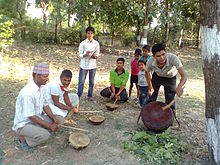Damai
दमाइँ | |
|---|---|
 Damai men playing traditional Damaha | |
| 472,862 (1.8% of Nepal's population) [1] | |
| Languages | |
| Nepali language (Khas kura) | |
| Religion | |
| Hinduism 96.59% (2011) | |
| Related ethnic groups | |
| Khas people, Kami, Badi, Sarki, Gandarbha/Gaine |
Damai (Nepali: दमाइँ) is an occupational caste found among Khas people.[2] They comprise 45 subgroups. Their surnames take after the subgroup they belong to.[3] People belonging to this caste are traditionally tailors[2] and musicians. They are adept at using the naumati baja- an ensemble of nine traditional musical instruments.[3] Damai is coined from musical instrument Damaha. The 1854 Nepalese Muluki Ain (Legal Code) categorized Damai as "Lower cast” category.[4] Thus, the tribal designation of Khas is given only in few context to Kami, Damai and Sarki due to traditional status.[2]
Due to many caste-based discriminations in Nepal, the government of Nepal legally abolished the caste-system and criminalized any caste-based discrimination, including "untouchability" (the ostracism of a specific caste) - in the year 1963 A.D.[5] With Nepal's step towards freedom and equality, Nepal, previously ruled by a Hindu monarchy was a Hindu nation which has now become a secular state,[6] and on 28 May 2008, it was declared a republic,[7] ending it as the Hindu Kingdom with its caste-based discriminations and the untouchability roots.[8]
According to 2011 Nepal census, Damai make up 1.8% of Nepal's population (or 472,862 peoples).[1] Damai are categorized under "Hill Dalit" among the 9 broad social groups, along with Kami, Badi, Sarki and Gaine by the Government of Nepal.[1]
References[]
- ^ a b c "Nepal Census 2011" (PDF).
- ^ a b c Whelpton 2005, p. 31.
- ^ a b The Splendour of Sikkim- Culture and Traditions of the Ethnic Communities of Sikkim. Cultural Affairs and Heritage Department, Government of India. 2017. p. 81.
- ^ Gurung, Harka (2005) Social Exclusion and Maoist Insurgency. Paper presented at National Dialogue Conference at ILO Convention 169 on Indigenous and Tribal peoples, Kathmandu, 19–20 January 2005.
- ^ Welle (www.dw.com), Deutsche. "Nepal: Deadly caste-based attacks spur outcry over social discrimination | DW | 16.06.2020". DW.COM. Retrieved 2021-02-28.
- ^ "Nepal king stripped of most powers". CNN. 18 May 2006. Retrieved 18 April 2020.
- ^ "Nepal votes to abolish monarchy". BBC News. 28 May 2008. Archived from the original on 7 January 2017. Retrieved 18 April 2020.
- ^ Crossette, Barbara (3 June 2001). "Birenda, 55, Ruler of Nepal's Hindu Kingdom". The New York Times. Retrieved 18 April 2020.
Bibliography[]
- Whelpton, John (2005). A History of Nepal. Cambridge University Press. ISBN 978-0521804707.
- Caste system in Nepal
- Dalit communities
- Nepal stubs
- Asian ethnic group stubs